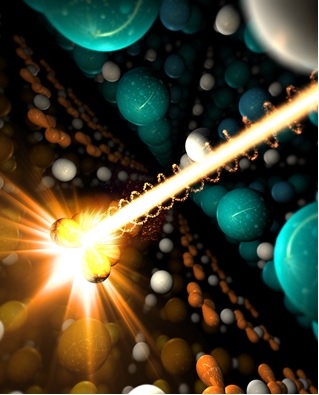
A fundamental feature of emergent materials such as oxide heterostructures is the interplay between charge, spin, orbital, and lattice degrees of freedom that induces a staggering variety of exotic phenomena including colossal magnetoresistance, metal-insulator transition, magnetoelasticity, and others. Moreover, each degree of freedom is tunable via doping, which results in changes of valence state and local structure and, therefore, variations of the ordered phase. This remarkable tunability motivates extensive and ongoing research on heterostructures in order to investigate new phenomena [1–3] and exploit them in device applications [4, 5]. In oxide heterostructures, control mechanisms other than doping are available, such as deliberately altering the interfacial polar discontinuity to modify the physical properties of thin-film structures [6–8].
LaAlO3 (lanthanum aluminium oxide, LAO) and SrTiO3 (strontium titanium oxide, STO) materials are perovskites, a class of mineral oxides whose unique electronic properties are of great interest to scientists. In general, these particular perovskites are insulators. But when sandwiched together, the resulting heterostructure can conduct electricity at the interface where the materials meet [1-8]. In fact, when cooled to near-absolute zero, this heterostructure becomes a superconductor [9], conducting electricity without resistance. The heterostructure also displays surprising magnetic qualities at the juncture of LAO and STO [10]. Neither material alone is magnetic, even when doped with impurities to tune its properties.
In order to confirm the existence of magnetism at the interface, researchers needed to understand the spin and orbital moments in the material. SSRL scientist Jun-Sik Lee studied heterostructures that consisted of 0–20 crystal-units thick LAO layers on STO substrates. These heterostructures were grown by the Hwang group of the Stanford Institute for Materials and Energy Sciences (SIMES), a joint SLAC-Stanford institute. Hwang is an expert in LAO/STO heterostructure research and has been studying it for a decade. X-ray spectroscopic measurements such as x-ray magnetic circular dichroism (XMCD) and polarization-dependent X-ray absorption spectroscopy (XAS) were performed at SSRL Beam Lines 13-1 and 10-1. In these techniques, the x-rays can be tuned to the exact wavelength needed to probe the properties of specific elements. The researchers used the x-rays to look specifically at the titanium in the STO slice of the heterostructure, or at oxygen in STO and LAO.
The expected magnetic moment and, hence, the resulting magnetic signal were so small that they neared the technical detection limit. To get a reliable signal, the researchers had to be extremely accurate in the data collection process. As a result, they found direct evidence for in-plane ferromagnetic order at the interface, with titanium Ti3+ character in the dxy orbital of the anisotropic t2g band, as shown in Figure 1. In other word, the all-spins direction is parallel to the LAO surface direction, known as “in-plane ferromagnetic order.”
The results also have important implications for other LAO/STO interface properties, such as its coexisting superconducting state, which occurs in the presence of the polarized titanium dxy orbital. These findings establish a striking example of emergent phenomena at oxide interfaces, underlining the potential of these materials to create novel multifunctional states in atomically precise transition metal oxide heterostructures with properties distinct from the individual components.
[1] A. Ohtomo, H. Y. Hwang, Nature 427, 423 (2004).
[2] J. Chakhalian et al., Nat. Phys. 2, 244 (2006).
[3] Y. Tokura, H. Y. Hwang, Nat. Mater. 7, 694 (2008).
[4] S. M. Wu et al., Nat. Mater. 9, 756 (2010).
[5] T. Yajima, Y. Hikita, H. Y. Hwang, Nat. Mater. 10, 198 (2011).
[6] N. Nakagawa, H. Y. Hwang, D. A. Muller, Nat. Mater. 5, 204 (2006).
[7] Y. Hotta, T. Susaki, H. Y. Hwang, Phys. Rev. Lett. 99, 236805 (2007).
[8] H. W. Jang et al., Science 331, 886 (2011).
[9] N. Reyren et al., Science 317, 1196 (2007).
[10] D. A. Dikin et al., Phys. Rev. Lett. 107, 056802 (2011).
J.-S. Lee, Y. W. Xie, H. K. Sato, C. Bell, Y. Hikita, H. Y. Hwang, and C.-C. Kao, “Titanium dxy Ferromagnetism at the LaAlO3/SrTiO3 Interface”, Nat. Mater. 12, 703 (2013), DOI: 10.1038/nmat3674




